Computer security experts has determined that Quick Email Login is a browser hijacker. The so-called browser hijacker is created to manipulate your web-browser’s settings such as newtab, homepage and search engine by default, to alter your home page or search engine, so that the affected web browser visits an annoying website instead of your selected one. In the steps below, we will explain all the general features of the Quick Email Login browser hijacker and it’s typical behavior on the computer, as well as effective ways to remove Quick Email Login from your MS Edge, Internet Explorer, Google Chrome and Mozilla Firefox.
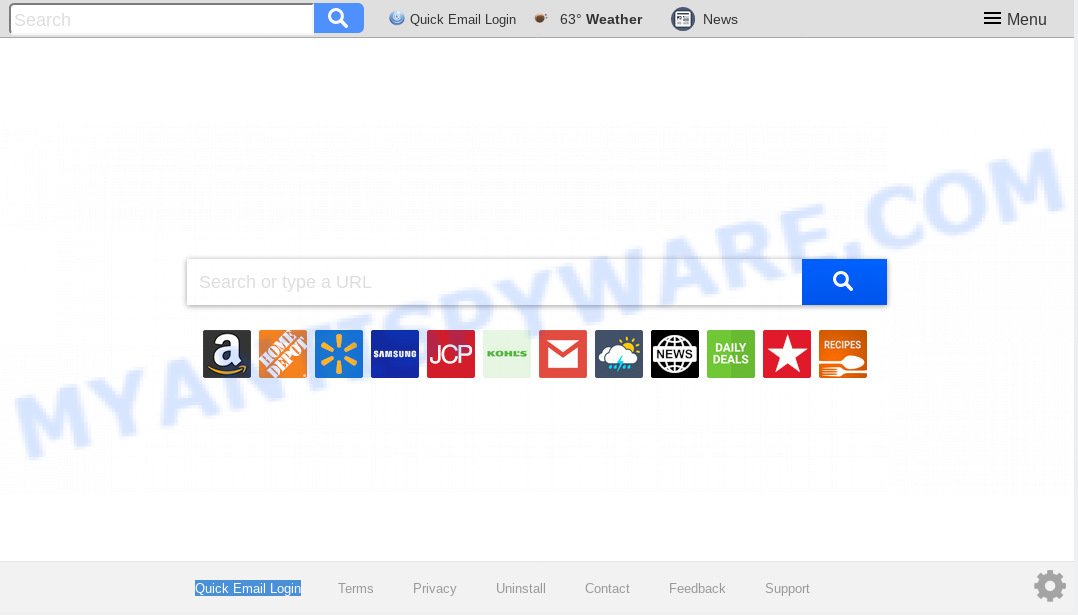
Quick Email Login makes unwanted changes to browser settings
When the Quick Email Login browser hijacker is installed on a personal computer, it can:
- set Quick Email Login as default search provider, newtab page, and start page;
- prevent users from changing search provider or startpage address;
- reroute your queries to sponsored web pages;
- provide altered search results;
- record your search queries;
- periodically redirects to questionable web-sites;
- display annoying ads;
- gather Internet browsing habits and sell it to third party companies.
Also, adware (sometimes called ‘ad-supported’ software) may be installed on the personal computer together with Quick Email Login hijacker. It will insert tons of advertisements directly to the websites that you view, creating a sense that advertisements has been added by the authors of the web page. Legal advertisements can be replaced on fake ads that will offer to download and install various unnecessary and harmful apps. Moreover, the Quick Email Login browser hijacker infection can be used to gather a wide variety of marketing-type data about you which can be later sold to third parties.
Threat Summary
| Name | Quick Email Login |
| Type | browser hijacker, search engine hijacker, home page hijacker, toolbar, unwanted new tab, redirect virus |
| Symptoms |
|
| Removal | Quick Email Login removal guide |
We strongly recommend that you perform the steps below which will help you to remove Quick Email Login using the standard features of Windows and some proven freeware.
How to Remove Quick Email Login from Windows 10 (8, 7, XP)
In the instructions below we will have a look at the browser hijacker infection and how to remove Quick Email Login from Firefox, Microsoft Internet Explorer, Chrome and Microsoft Edge internet browsers for Microsoft Windows OS, natively or by using a few free removal utilities. Read it once, after doing so, please print this page as you may need to close your browser or restart your computer.
To remove Quick Email Login, perform the following steps:
- How to remove Quick Email Login manually
- How to automatically remove Quick Email Login
- Block Quick Email Login and other unwanted web-pages
- Method of Quick Email Login hijacker intrusion into your PC system
- To sum up
How to remove Quick Email Login manually
The following instructions is a step-by-step guide, which will help you manually remove Quick Email Login from the Internet Explorer, Google Chrome, Microsoft Edge and Mozilla Firefox.
Delete Quick Email Login associated software by using Windows Control Panel
The best way to begin the PC cleanup is to uninstall unknown and suspicious programs. Using the Windows Control Panel you can do this quickly and easily. This step, in spite of its simplicity, should not be ignored, because the removing of unneeded apps can clean up the Microsoft Edge, Mozilla Firefox, Internet Explorer and Chrome from ads hijackers and so on.
Windows 8, 8.1, 10
First, click Windows button

After the ‘Control Panel’ opens, press the ‘Uninstall a program’ link under Programs category like below.

You will see the ‘Uninstall a program’ panel like below.

Very carefully look around the entire list of programs installed on your PC system. Most probably, one of them is the hijacker responsible for Quick Email Login . If you have many software installed, you can help simplify the search of harmful applications by sort the list by date of installation. Once you have found a suspicious, unwanted or unused program, right click to it, after that click ‘Uninstall’.
Windows XP, Vista, 7
First, click ‘Start’ button and select ‘Control Panel’ at right panel as displayed in the figure below.

When the Windows ‘Control Panel’ opens, you need to press ‘Uninstall a program’ under ‘Programs’ like below.

You will see a list of applications installed on your computer. We recommend to sort the list by date of installation to quickly find the programs that were installed last. Most likely, it’s the hijacker responsible for redirects to Quick Email Login. If you’re in doubt, you can always check the program by doing a search for her name in Google, Yahoo or Bing. When the application which you need to remove is found, simply click on its name, and then press ‘Uninstall’ as displayed in the figure below.

Remove Quick Email Login from Chrome
The browser hijacker infection can change your Chrome settings without your knowledge. You may see the Quick Email Login as your search provider or startpage, additional extensions and toolbars. Reset Google Chrome browser will help you to remove Quick Email Login and reset the unwanted changes caused by browser hijacker. It’ll save your personal information such as saved passwords, bookmarks, auto-fill data and open tabs.

- First, start the Google Chrome and click the Menu icon (icon in the form of three dots).
- It will display the Google Chrome main menu. Choose More Tools, then click Extensions.
- You’ll see the list of installed add-ons. If the list has the extension labeled with “Installed by enterprise policy” or “Installed by your administrator”, then complete the following tutorial: Remove Chrome extensions installed by enterprise policy.
- Now open the Chrome menu once again, click the “Settings” menu.
- Next, click “Advanced” link, that located at the bottom of the Settings page.
- On the bottom of the “Advanced settings” page, click the “Reset settings to their original defaults” button.
- The Google Chrome will show the reset settings dialog box as on the image above.
- Confirm the web browser’s reset by clicking on the “Reset” button.
- To learn more, read the article How to reset Chrome settings to default.
Get rid of Quick Email Login search from Mozilla Firefox
The Mozilla Firefox reset will remove unwanted search provider and start page like Quick Email Login, modified preferences, extensions and security settings. Essential information such as bookmarks, browsing history, passwords, cookies, auto-fill data and personal dictionaries will not be removed.
Start the Mozilla Firefox and press the menu button (it looks like three stacked lines) at the top right of the web-browser screen. Next, click the question-mark icon at the bottom of the drop-down menu. It will show the slide-out menu.
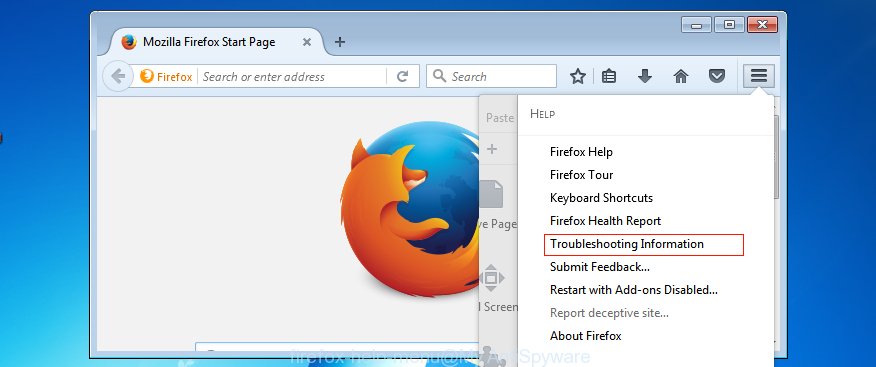
Select the “Troubleshooting information”. If you are unable to access the Help menu, then type “about:support” in your address bar and press Enter. It bring up the “Troubleshooting Information” page as displayed below.
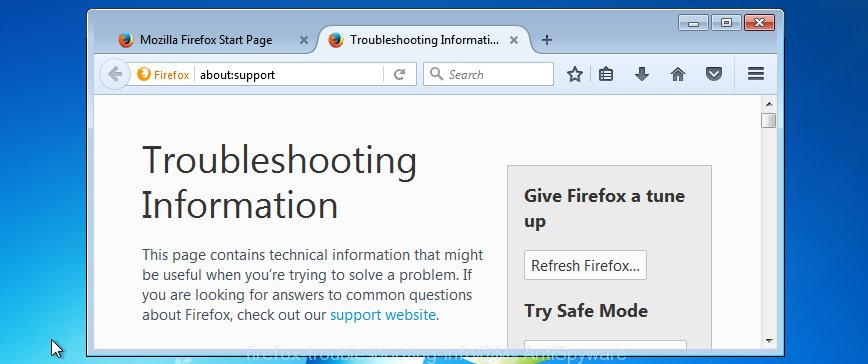
Click the “Refresh Firefox” button at the top right of the Troubleshooting Information page. Select “Refresh Firefox” in the confirmation prompt. The Firefox will begin a task to fix your problems that caused by the Quick Email Login browser hijacker. When, it’s done, click the “Finish” button.
Delete Quick Email Login from Internet Explorer
The Microsoft Internet Explorer reset is great if your browser is hijacked or you have unwanted addons or toolbars on your web-browser, that installed by a malicious software.
First, start the Internet Explorer. Next, click the button in the form of gear (![]() ). It will show the Tools drop-down menu, press the “Internet Options” like below.
). It will show the Tools drop-down menu, press the “Internet Options” like below.

In the “Internet Options” window click on the Advanced tab, then click the Reset button. The Internet Explorer will show the “Reset Internet Explorer settings” window as displayed in the following example. Select the “Delete personal settings” check box, then click “Reset” button.

You will now need to reboot your computer for the changes to take effect.
How to automatically remove Quick Email Login
Is your Windows computer infected by browser hijacker? Then don’t worry, in the following instructions, we are sharing best malware removal tools that has the ability to get rid of Quick Email Login from the IE, Firefox, Chrome and Edge and your system.
Automatically get rid of Quick Email Login with Zemana Free
Zemana is a malicious software removal utility made for Microsoft Windows. This tool will help you delete Quick Email Login hijacker, various types of malware (including adware and potentially unwanted apps) from your system. It has simple and user friendly interface. While the Zemana Anti Malware (ZAM) does its job, your PC will run smoothly.
- Zemana Anti-Malware (ZAM) can be downloaded from the following link. Save it to your Desktop so that you can access the file easily.
Zemana AntiMalware
164813 downloads
Author: Zemana Ltd
Category: Security tools
Update: July 16, 2019
- Once you have downloaded the install file, make sure to double click on the Zemana.AntiMalware.Setup. This would start the Zemana install on your machine.
- Select install language and press ‘OK’ button.
- On the next screen ‘Setup Wizard’ simply click the ‘Next’ button and follow the prompts.

- Finally, once the install is done, Zemana AntiMalware will start automatically. Else, if doesn’t then double-click on the Zemana Anti Malware icon on your desktop.
- Now that you have successfully install Zemana Anti Malware (ZAM), let’s see How to use Zemana Anti-Malware (ZAM) to delete Quick Email Login search from your computer.
- After you have started the Zemana Anti-Malware, you’ll see a window as displayed in the figure below, just click ‘Scan’ button to perform a system scan with this tool for the hijacker infection.

- Now pay attention to the screen while Zemana AntiMalware (ZAM) scans your system.

- When Zemana Free has finished scanning, Zemana Anti-Malware (ZAM) will show a list of all threats detected by the scan. In order to delete all items, simply click ‘Next’ button.

- Zemana Anti-Malware may require a reboot computer in order to complete the Quick Email Login home page removal process.
- If you want to permanently remove hijacker from your PC, then click ‘Quarantine’ icon, select all malware, adware, PUPs and other threats and click Delete.
- Restart your computer to complete the browser hijacker removal procedure.
Delete Quick Email Login hijacker infection and malicious extensions with HitmanPro
HitmanPro is a free tool which can identify hijacker infection which cause a redirect to Quick Email Login webpage. It is not always easy to locate all the junk apps that your computer might have picked up on the Internet. HitmanPro will scan for the adware, hijacker infections and other malicious software you need to erase.
Download HitmanPro on your MS Windows Desktop from the link below.
When the download is finished, open the file location. You will see an icon like below.

Double click the Hitman Pro desktop icon. After the utility is launched, you will see a screen as shown on the screen below.
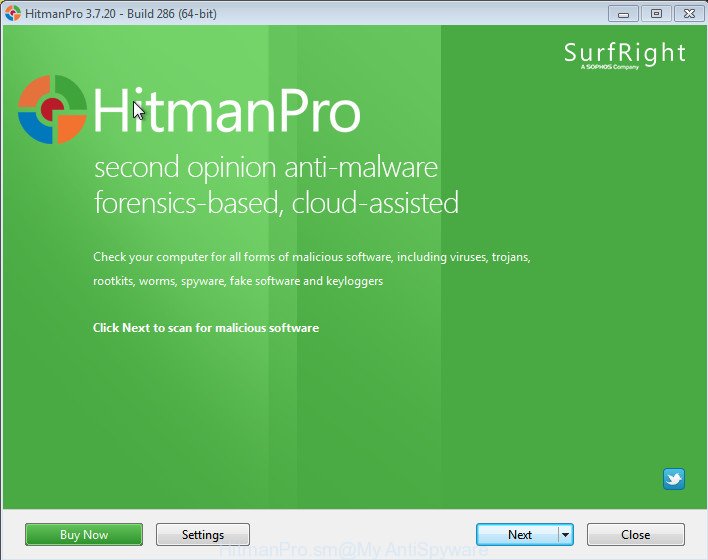
Further, click “Next” button to perform a system scan with this utility for the hijacker that responsible for web browser redirect to the annoying Quick Email Login web-site. This procedure can take quite a while, so please be patient. After finished, HitmanPro will open a screen that contains a list of malicious software that has been found as displayed below.
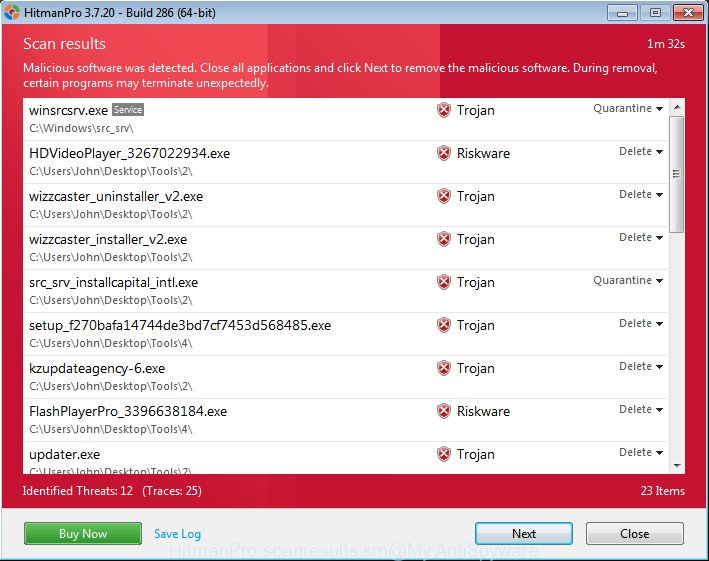
Next, you need to click “Next” button. It will show a dialog box, press the “Activate free license” button.
Run MalwareBytes Anti-Malware (MBAM) to delete Quick Email Login start page
If you are still having problems with the Quick Email Login — or just wish to check your PC system occasionally for browser hijacker infection and other malware — download MalwareBytes Free. It’s free for home use, and searches for and deletes various unwanted programs that attacks your PC or degrades PC system performance. MalwareBytes Anti-Malware (MBAM) can remove adware software, PUPs as well as malware, including ransomware and trojans.
MalwareBytes can be downloaded from the following link. Save it on your Desktop.
327071 downloads
Author: Malwarebytes
Category: Security tools
Update: April 15, 2020
After downloading is complete, close all programs and windows on your computer. Open a directory in which you saved it. Double-click on the icon that’s named mb3-setup as displayed in the figure below.
![]()
When the installation begins, you will see the “Setup wizard” that will help you install Malwarebytes on your personal computer.
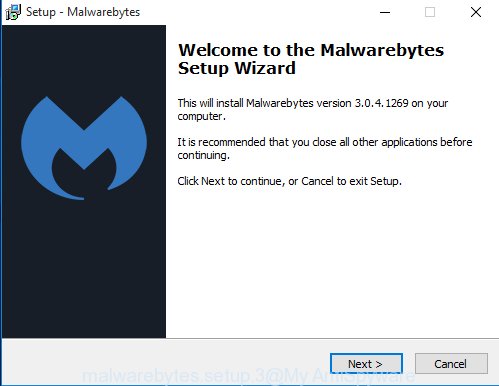
Once installation is finished, you’ll see window like the one below.
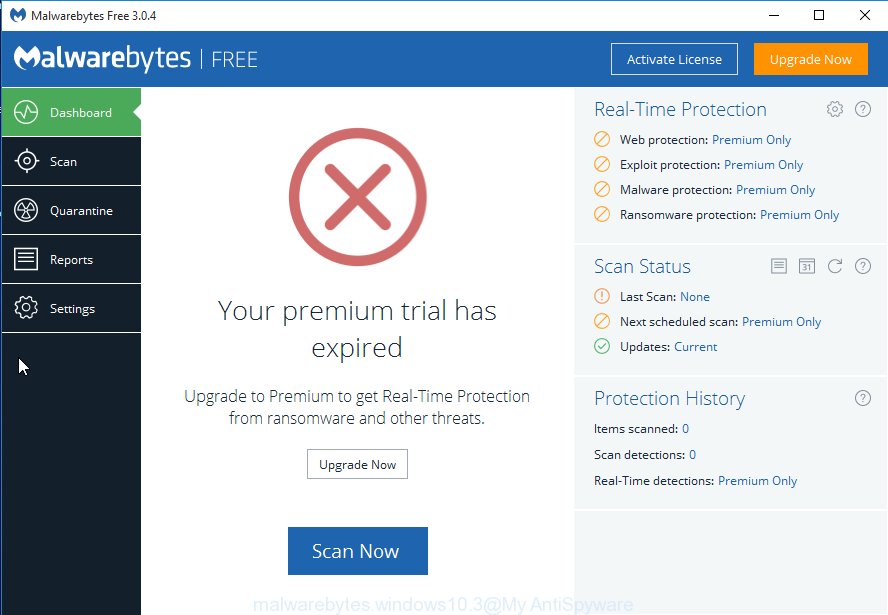
Now click the “Scan Now” button . MalwareBytes Free tool will start scanning the whole PC to find out hijacker related to Quick Email Login . When a malware, adware or potentially unwanted applications are detected, the number of the security threats will change accordingly. Wait until the the checking is finished.
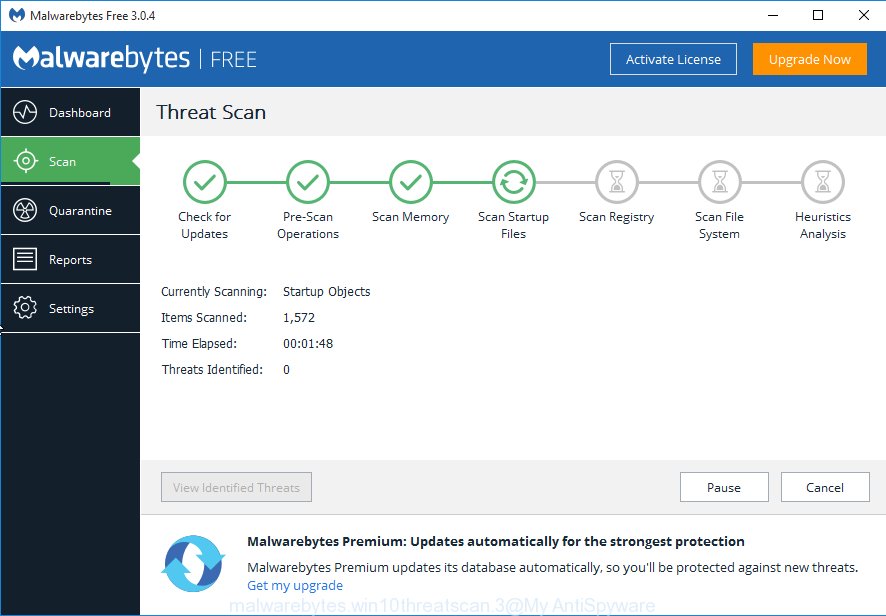
When mbam} is finished scanning your personal computer, a list of all items found is created. Next, you need to click “Quarantine Selected” button.
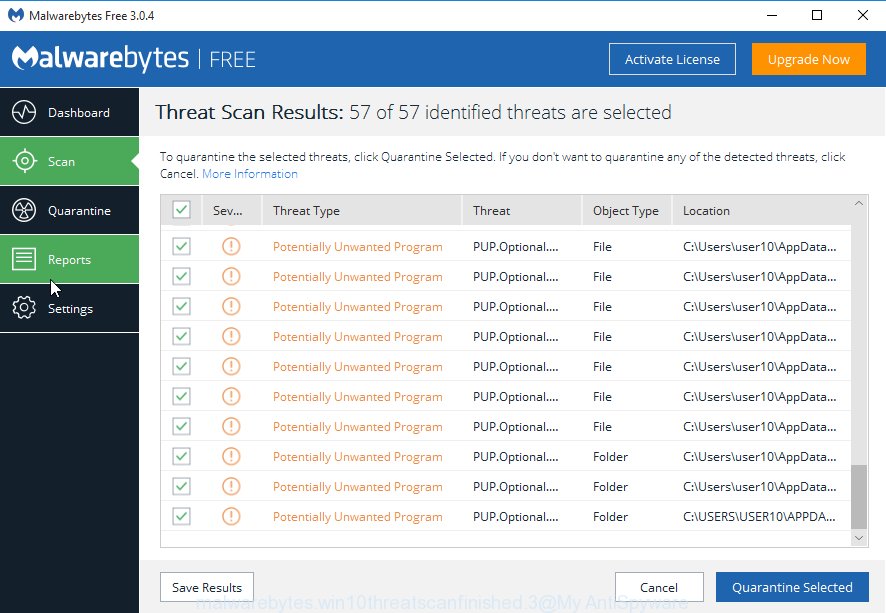
The Malwarebytes will now begin to remove hijacker related to Quick Email Login redirect. Once the procedure is done, you may be prompted to reboot your personal computer.

The following video explains step-by-step guide on how to delete hijacker infection, adware and other malware with MalwareBytes.
Block Quick Email Login and other unwanted web-pages
If you surf the Internet, you can’t avoid malvertising. But you can protect your browser against it. Download and use an ad-blocker program. AdGuard is an ad blocking which can filter out a large count of of the malicious advertising, stoping dynamic scripts from loading malicious content.
- AdGuard can be downloaded from the following link. Save it to your Desktop so that you can access the file easily.
Adguard download
26843 downloads
Version: 6.4
Author: © Adguard
Category: Security tools
Update: November 15, 2018
- After downloading it, run the downloaded file. You will see the “Setup Wizard” program window. Follow the prompts.
- Once the installation is complete, click “Skip” to close the install program and use the default settings, or click “Get Started” to see an quick tutorial which will help you get to know AdGuard better.
- In most cases, the default settings are enough and you don’t need to change anything. Each time, when you start your PC system, AdGuard will start automatically and stop unwanted ads, block Quick Email Login, as well as other harmful or misleading web-pages. For an overview of all the features of the program, or to change its settings you can simply double-click on the icon named AdGuard, which can be found on your desktop.
Method of Quick Email Login hijacker intrusion into your PC system
The browser hijacker come bundled with certain free software. So always read carefully the installation screens, disclaimers, ‘Terms of Use’ and ‘Software license’ appearing during the install process. Additionally pay attention for third-party apps that are being installed along with the main application. Ensure that you unchecked all of them! Also, run an ad blocking application that will help to stop malicious, misleading, illegitimate or untrustworthy web-sites.
To sum up
Now your PC should be free of the Quick Email Login browser hijacker infection and other internet browser’s malicious plugins. We suggest that you keep AdGuard (to help you block unwanted popups and undesired malicious web-pages) and Zemana Anti-Malware (ZAM) (to periodically scan your computer for new browser hijackers and other malware). Probably you are running an older version of Java or Adobe Flash Player. This can be a security risk, so download and install the latest version right now.
If you are still having problems while trying to delete Quick Email Login from the IE, Mozilla Firefox, Chrome and Edge, then ask for help here here.






















